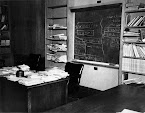Final LHC magnet goes underground
Geneva, 30 April 2009. The 53rd and final replacement magnet for CERN's1 Large Hadron Collider (LHC) was lowered into the accelerator's tunnel today, marking the end of repair work above ground following the incident in September last year that brought LHC operations to a halt. Underground, the magnets are being interconnected, and new systems installed to prevent similar incidents happening again. The LHC is scheduled to restart in the autumn, and to run continuously until sufficient data have been accumulated for the LHC experiments to announce their first results.
to prevent similar incidents happening again. The LHC is scheduled to restart in the autumn, and to run continuously until sufficient data have been accumulated for the LHC experiments to announce their first results. "This is an important milestone in the repair process," said CERN's Director for Accelerators and Technology, Steve Myers. "It gets us close to where we were before the incident, and allows us to concentrate our efforts on installing the systems that will ensure a similar incident won't happen again."
The final magnet, a quadrupole designed to focus the beam, was lowered this afternoon and has started its journey to Sector 3-4, scene of the September incident. With all the magnets now underground, work in the tunnel will focus on connecting the magnets together and installing new safety systems, while on the surface, teams will shift their attention to replenishing the LHC's supply of spare magnets.
In total 53 magnets were removed from Sector 3-4. Sixteen that sustained minimal damage were refurbished and put back into the tunnel. The remaining 37 were replaced by spares and will themselves be refurbished to provide spares for the future.
"Now we will split our team into two parts," explained Lucio Rossi, Deputy head of CERN's Technology Department. "The main group will carry out interconnection work in the tunnel while a second will rebuild our stock of spare magnets."
The LHC repair process can be divided into three parts. Firstly, the repair itself, which is nearing completion with the installation of the last magnet today. Secondly, systems are being installed to monitor the LHC closely and ensure that similar incidents to that of last September cannot happen again. This work will continue into the summer. Finally, extra pressure relief valves are being installed to release helium in a safe and controlled manner should there be leaks inside the LHC's cryostat at any time in the machine's projected 15-20 year operational lifetime.
CERN is publishing regular updates on the LHC in its internal Bulletin, available at www.cern.ch/bulletin, as well as via twitter and YouTube at www.twitter.com/cern and www.youtube.com/cern
1. CERN, the European Organization for Nuclear Research, is the world's leading laboratory for particle physics. It has its headquarters in Geneva. At present, its Member States are Austria, Belgium, Bulgaria, the Czech Republic, Denmark, Finland, France, Germany, Greece, Hungary, Italy, Netherlands, Norway, Poland, Portugal, Slovakia, Spain, Sweden, Switzerland and the United Kingdom. India, Israel, Japan, the Russian Federation, the United States of America, Turkey, the European Commission and UNESCO have Observer status.







